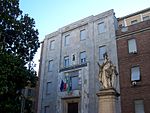Natural History Museum, Pavia
Museums in PaviaNatural history museums in ItalyUniversity museums in ItalyUniversity of Pavia

The Natural History Museum (Italian: Museo di Storia Naturale) in Pavia, Italy is a museum displaying many natural history specimens, located in Palazzo Botta Adorno. Founded in 1775, it was one of the oldest museums of natural history in Europe. It currently forms the University of Pavia museum network, along with 5 other museums — the University History Museum, Museum of Electrical Technology, Museum of Archeology, Museum Camillo Golgi and Museum of Mineralogy.
Excerpt from the Wikipedia article Natural History Museum, Pavia (License: CC BY-SA 3.0, Authors, Images).Natural History Museum, Pavia
Piazza Antoniotto Botta Adorno, Pavia Ticinello
Geographical coordinates (GPS) Address Nearby Places Show on map
Geographical coordinates (GPS)
| Latitude | Longitude |
|---|---|
| N 45.188 ° | E 9.15 ° |
Address
Botta - Adorno Palace
Piazza Antoniotto Botta Adorno 4
27100 Pavia, Ticinello
Lombardy, Italy
Open on Google Maps










